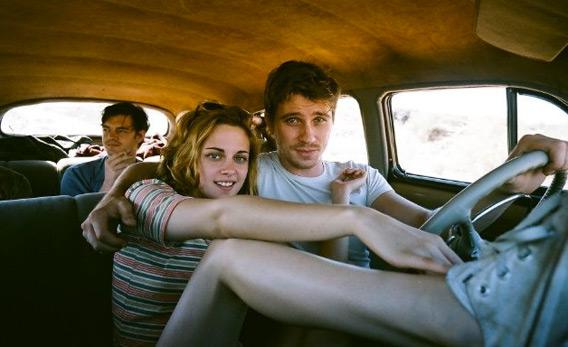On the Road is not a great movie, but it’s a pretty interesting work of literary criticism. The film, written by Puerto Rican playwright José Rivera and directed by the Brazilian Walter Salles, adapts Jack Kerouac’s legendary 1957 novel of the same name, in which Kerouac’s alter-ego, Sal Paradise, buses, hitchhikes, and rides in a car—usually in the backseat; he hardly ever drives himself—between New York, Denver, California, and Mexico City. A few scenes catch the verve of Kerouac’s voice-driven novel: Paradise and several strangers singing in the back of a truck; a car soaring across a flat Western landscape; a sweaty dance sequence. But throughout—whether on purpose or, as sometimes seems to be the case, accidentally—the movie makes one reconsider, and not entirely fondly, the beloved, messy, sporadically thrilling, frequently dispiriting, and widely misunderstood book that inspired it.
The purposeful critique comes mostly by way of the movie’s female characters—who are, as a rule, played by actors more charismatic than the two male leads. Novel and movie each begin with Sal (Sam Riley) meeting Dean Moriarty (Garrett Hedlund), a poor 21-year-old from Denver who has come to New York, toting Swann’s Way, hoping to study at Columbia and become a writer. Riley looks the part of Paradise, pretty much, though he never quite shakes his British affect; his adopted accent sounds somewhere between Daniel Day-Lewis in Gangs of New York and Christian Bale as Batman. Hedlund is a naturally raspy Minnesotan, so when the two meet up with Viggo Mortensen as Bull Lee (aka William S. Burroughs; the names in the largely nonfictional novel were changed, Kerouac said, for legal reasons), the dialogue scenes become a gravelly voice competition. Mortensen, unsurprisingly, wins.
But for sheer screen presence all of them lose to the women—especially Kristen Stewart as Dean’s 16-year-old soon-to-be ex-wife Marylou. From the moment we see her licking rolling papers to make a joint (Sal tells her he’s never seen a girl do that), she holds the camera like no one else in the film. Kirsten Dunst, as Dean’s next wife, Camille, who’s working on a graduate degree in art history in Denver, similarly distracts our attention from Sal and Dean, and so does Amy Adams as Bull’s wife, Jane—aka Joan Vollmer, who was killed by Burroughs in what was apparently a drunken game of “William Tell.”
Salles wants us to pay more attention to them than Kerouac did: He cuts from a scene of Bull, Sal, and Dean discussing Céline to a shot of Jane and Marylou cleaning the kitchen and telling another woman—Galatea Dunkel, abandoned by her husband at Bull’s house—that she needs to give her man blow jobs if she wants to keep him. And Dean’s (temporary) abandonment of Camille after the pair have a baby is much more prominent here than it is in the novel. The real-life Camille, Caroyln Cassady, is a consultant on the movie and author of Off the Road: Twenty Years with Cassady, Kerouac, and Ginsberg. One suspects that Salles has not only read that book but also the memoir by one-time Kerouac amour Joyce Johnson, Minor Characters, which describes, as The New Yorker put it, “the folly of young women rebelling against their well-meaning parents only to become subservient to indifferent men.”
It’s not that Kerouac was unaware of all the damage that Dean, especially, did. But he forgives it all for Dean’s sexy, charismatic impulsiveness, which to him seems holy. “Bitterness, recriminations, advice, morality, sadness—everything was behind him,” Kerouac writes, “and ahead of him was the ragged and ecstatic joy of pure being.” As Dean, Hedlund gives it his shirtless (and sometimes pantsless) all and has his moments, but if it is humanly possible to convey the “wild yea-saying overburst of American joy” that Sal attributes to Dean—and I have my doubts—then he doesn’t quite succeed. When Hedlund delivers a big monologue to Sal about a interracial four-way—a recitation of which got Hedlund the part, Salles has said—all I could think was: This is a guy who went on and on to you about his orgies.
Maybe it’s just that the transgressions of the Beats don’t feel that transgressive anymore. Kerouac may have thrilled to “the enormous presence of whole great Mexico” with its “billion tortillas frying and smoking in the night,” but when, in the movie, Sal and Dean visit a brothel in Mexico City, the term sex tourism is hard to keep from your mind.
This is a sort of criticism I don’t think Salles intended, but which, watching the film, seems inevitable. Some things just feel different when they are thrust visibly in front of you rather than filtered through the ramshackle prose of Jack Kerouac. Fairly early in the movie, Riley delivers, in his Batman growl, some of the author’s most famous lines. (Though here and elsewhere, Salles and Rivera opt for the slightly different prose of the “scroll,” a draft of the book that Kerouac wrote in 1951 on 120 feet of tracing paper taped together and cut to fit into a typewriter.) The “only people that interest me are the mad ones,” he says, “the ones who are mad to live, mad to talk, desirous of everything at the same time, the ones that never yawn or say a commonplace thing but burn, burn, burn like roman candles across the night.”
While we hear this, Hedlund and Tom Sturridge—a pleasingly vulnerable and goofy incarnation of Carlo Marx, aka the young Allen Ginsberg—are walking bouncily down an alleyway, jumping in puddles and generally making bumptious asses of themselves. Which is pretty much what Sal, in the book, says they’re doing as he shares that thought. But somehow, when reading it, you forget he’s watching a couple of twentysomethings yell half-baked philosophy at each other on a noisy city night. Watching them on screen, it occurs to you: The Beat generation was just a bunch of guys.
